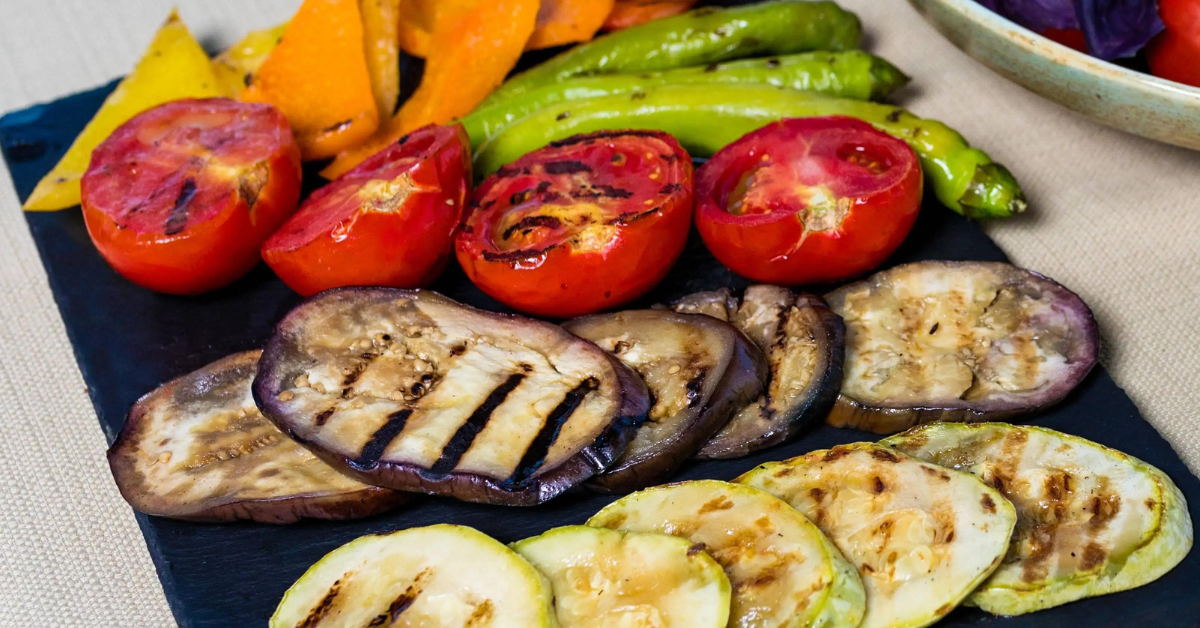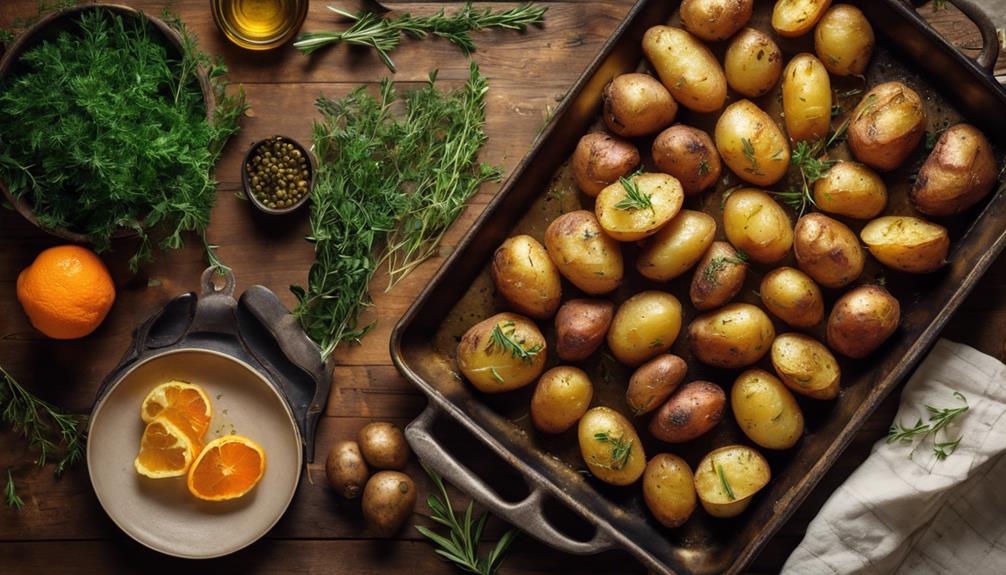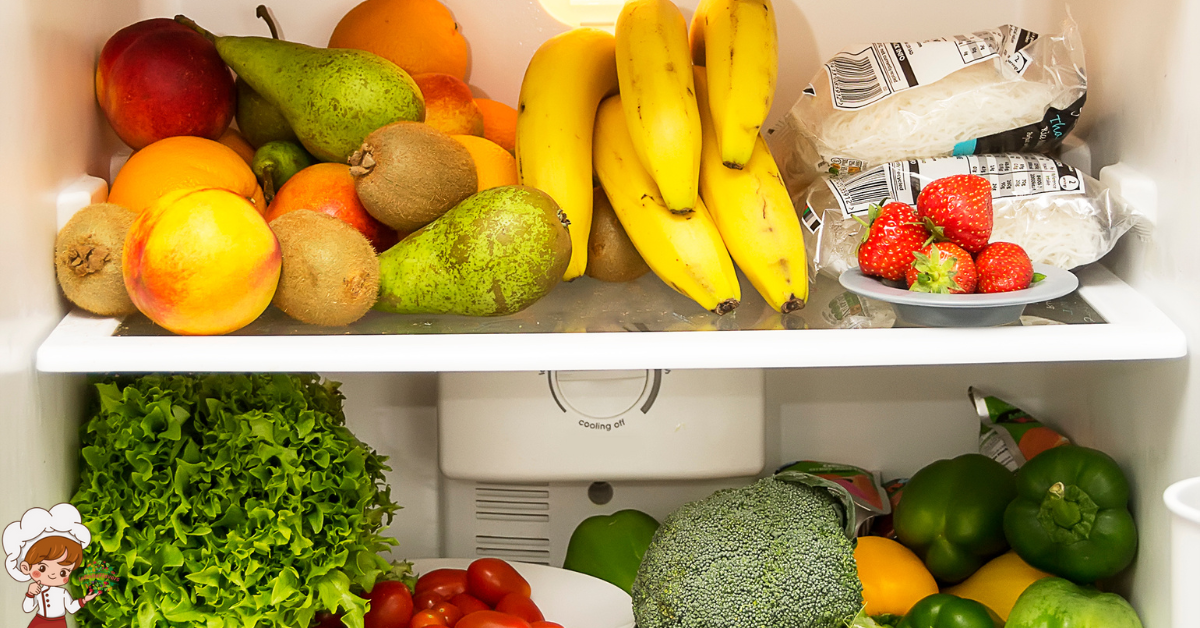The Best Cheesy Comfort Dish Hashbrown Casserole
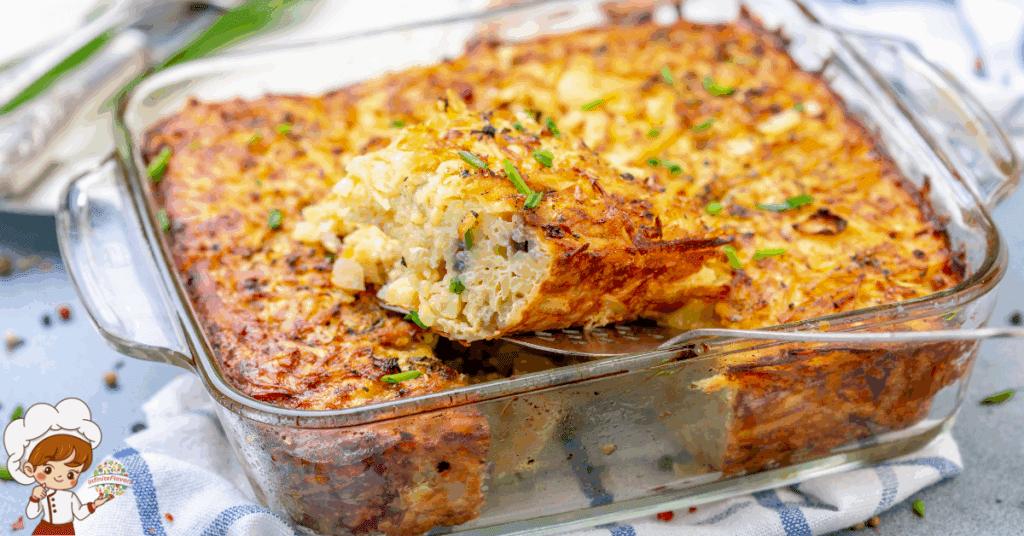
Best Cheesy Comfort Dish Hashbrown Casserole; Few dishes capture the essence of American comfort food quite like hashbrown casserole. With its creamy texture, crispy topping, and rich, cheesy flavor, hashbrown casserole has earned a permanent spot on dinner tables, potluck spreads, and holiday buffets across the country.
Whether served as a side dish or a main course, it’s a versatile, crowd-pleasing staple that evokes a sense of home, warmth, and nostalgia. But behind this unassuming dish lies a rich culinary history, shaped by cultural influences, convenience foods, and regional cooking traditions. In this blog, we’ll explore the fascinating origins of hashbrown casserole, its evolution over time, and how it became one of America’s most beloved casseroles. A detailed FAQ at the end will also address common questions about this iconic dish.
The Origins of Hashbrowns: A Breakfast Staple with European Roots
To understand the origins of hashbrown casserole, we must begin with the hashbrown itself. Hashbrowns, in their simplest form, are shredded or diced potatoes cooked until browned and crispy. They are a staple of American breakfast menus and often paired with eggs, bacon, and toast. The concept of frying leftover potatoes, however, dates back centuries and has roots in European peasant cooking traditions.
The name “hashbrown” is derived from the French word “hacher,” meaning “to chop.” This technique of finely chopping and pan-frying potatoes was popular in Europe long before it made its way to American kitchens. In the 19th century, Americans began to adopt the practice of frying grated or chopped potatoes, especially in diners and hotels that served hearty breakfasts. By the early 20th century, hashbrowns were a recognized breakfast item in the United States, praised for their simplicity, affordability, and satisfying texture.
The Rise of the Casserole in American Cooking
While hashbrowns were becoming a breakfast staple, another culinary phenomenon was taking hold in the American kitchen: the casserole. The word “casserole” originates from the French word for “saucepan,” but in the U.S., it came to refer to a dish that is baked in one dish—usually combining a starch, a protein, a binder (like cream or soup), and a topping.
Casseroles rose to popularity during the 1940s and 1950s, thanks to the advent of convenience foods such as canned soup, frozen vegetables, and pre-shredded cheese. The post-World War II era brought significant changes to the American household, including a rise in dual-income families and the need for quick, affordable meals. Casseroles met these demands perfectly: they were easy to assemble, economical, and could feed a crowd with minimal effort.
The popularity of casseroles exploded during the mid-20th century, and regional varieties began to emerge across the country. Tuna noodle casserole, green bean casserole, and Tater Tot hotdish are just a few examples. This period set the stage for the eventual invention of hashbrown casserole, a dish that would marry the best qualities of hashbrowns and the classic American casserole.
The Birth of Hashbrown Casserole
While the precise origin of hashbrown casserole is difficult to trace, its most recognizable version—made with frozen shredded hashbrowns, canned cream of chicken soup, sour cream, cheese, and butter—appears to have emerged in the American South during the latter half of the 20th century. One of the earliest and most influential versions was popularized by the Cracker Barrel Old Country Store restaurant chain.
Cracker Barrel, founded in 1969 in Lebanon, Tennessee, helped introduce hashbrown casserole to a national audience. Their version, served as a breakfast side or dinner accompaniment, became wildly popular among diners and inspired countless copycat recipes. The dish was prized for its creamy interior, cheesy richness, and crispy, golden crust—qualities that appealed to both Southern palates and comfort food lovers everywhere.
Though Cracker Barrel never officially published its exact recipe, home cooks and food bloggers reverse-engineered the dish, creating versions that used accessible ingredients such as frozen hashbrowns, cheddar cheese, canned soup, and sour cream. These adaptations made hashbrown casserole a regular fixture in family cookbooks, community church potlucks, and online recipe forums.
A Southern Comfort Classic
Hashbrown casserole’s popularity in the South is no accident. Southern cuisine is known for its deep commitment to comfort food, and casseroles are a central part of that culinary identity. The region’s food traditions emphasize richness, heartiness, and hospitality—qualities that hashbrown casserole embodies in full.
In Southern households, hashbrown casserole often appears at holiday gatherings, Sunday dinners, and funerals. It’s one of those versatile dishes that works just as well on a Thanksgiving table as it does at a backyard barbecue. Its creamy texture and savory flavor make it a comforting accompaniment to ham, roast chicken, meatloaf, or fried pork chops. Many Southern families have their own twist on the recipe, whether it’s a crunchy cornflake topping, a dash of hot sauce, or a handful of chopped onions or peppers added to the mix.
The dish’s affordability and ease of preparation also contribute to its lasting appeal. Most recipes rely on inexpensive pantry staples and frozen goods, making it accessible for cooks of all skill levels. This combination of taste, tradition, and thriftiness has ensured hashbrown casserole’s continued prominence in Southern cooking.
Regional Variations and Modern Adaptations
Although hashbrown casserole is strongly associated with the South, it has found fans across the United States. In the Midwest, it often appears at church suppers and community dinners. In the West, it’s served as part of hearty brunch spreads alongside scrambled eggs and sausages. The dish’s adaptability has allowed it to evolve in exciting ways over the years.
Some cooks add proteins such as diced ham, ground sausage, or shredded chicken to make hashbrown casserole a main dish rather than a side. Others incorporate vegetables like bell peppers, mushrooms, spinach, or jalapeños for added color and flavor. Health-conscious variations use Greek yogurt in place of sour cream or reduced-fat cheese to lighten the dish without sacrificing taste.
In upscale culinary settings, chefs have even created gourmet versions of hashbrown casserole, using artisanal cheeses, caramelized onions, and homemade béchamel sauce instead of canned soup. Vegan and dairy-free renditions are also gaining traction, replacing traditional ingredients with plant-based alternatives to meet the needs of modern dietary preferences.
Despite these variations, the essence of hashbrown casserole remains the same: a warm, creamy, and satisfying dish that brings people together.
The Influence of Convenience Foods
One of the defining characteristics of hashbrown casserole is its reliance on convenience ingredients—particularly frozen hashbrowns and canned soup. These components not only simplify the cooking process but also reflect broader trends in American culinary history.
Frozen hashbrowns became widely available in grocery stores during the mid-20th century, thanks to advances in freezing technology and the growing popularity of breakfast foods. These pre-shredded potatoes allowed home cooks to skip the labor-intensive step of peeling and grating potatoes, saving time and effort.
Canned soup, especially cream of chicken and cream of mushroom, also played a crucial role. Introduced by the Campbell Soup Company in the early 20th century, condensed soups quickly became a staple in American kitchens. They were affordable, shelf-stable, and versatile, making them an ideal ingredient for casseroles. By combining frozen hashbrowns with canned soup, shredded cheese, and sour cream, cooks created a dish that was both convenient and deeply comforting.
This use of processed ingredients has sometimes drawn criticism from culinary purists. However, it also highlights the ingenuity of home cooks, who embraced available resources to create meals that were economical, satisfying, and perfect for sharing.
Hashbrown Casserole in Popular Culture
Hashbrown casserole may not be a celebrity dish in the same way as macaroni and cheese or fried chicken, but it holds a quiet place in American popular culture. It’s featured on the menus of diners and family-style restaurants, included in countless cookbooks, and celebrated in food blogs and social media posts that highlight nostalgic or regional cooking.
It also frequently appears in community cookbooks, passed down through generations and shared among neighbors, church groups, and friends. These grassroots cookbooks often feature handwritten notes, personal variations, and memories tied to the dish—proof of its deeply personal and cultural resonance.
In online food communities, hashbrown casserole is often lauded for its versatility, ease, and ability to feed a crowd. It’s the kind of dish that sparks discussion and debate: Should the topping be cornflakes or crushed crackers? Is cream of mushroom better than cream of chicken? These conversations reflect the dish’s status as a cherished comfort food with room for creative interpretation.
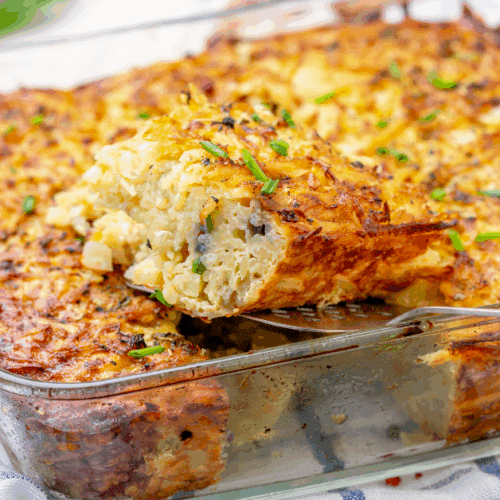
Classic Hashbrown Casserole Recipe
Ingredients
- Ingredients:
- 1 32-ounce bag frozen shredded hashbrowns, thawed
- 1 10.5-ounce can cream of chicken soup (or cream of mushroom for a vegetarian version)
- 2 cups shredded sharp cheddar cheese
- 1 cup sour cream
- ½ cup melted unsalted butter plus more for greasing the pan
- ½ cup finely chopped onion
- 1 teaspoon salt
- ½ teaspoon black pepper
- Optional topping: 1 ½ cups crushed cornflakes mixed with 2 tablespoons melted butter
Instructions
- Instructions:
- Preheat the oven to 350°F (175°C). Lightly grease a 9×13-inch baking dish with butter or nonstick spray.
- Combine ingredients: In a large mixing bowl, stir together the thawed hashbrowns, cream of chicken soup, shredded cheddar cheese, sour cream, melted butter, chopped onion, salt, and pepper. Mix until everything is evenly combined.
- Transfer to baking dish: Spoon the mixture into the prepared baking dish and spread it into an even layer.
- Add the topping (optional): In a small bowl, mix the crushed cornflakes with 2 tablespoons of melted butter. Sprinkle the mixture evenly over the top of the casserole.
- Bake: Place the casserole in the preheated oven and bake uncovered for 45–50 minutes, or until the top is golden brown and the edges are bubbling.
- Serve: Let the casserole rest for 5–10 minutes before serving to allow it to set. Serve warm as a side dish or hearty main course.
FAQ: Best Cheesy Comfort Dish Hashbrown Casserole
What is hashbrown casserole made of?
Hashbrown casserole typically includes frozen shredded hashbrowns, cheddar cheese, sour cream, canned cream of chicken soup, butter, and seasonings. Optional ingredients include onions, peppers, or a crunchy topping like cornflakes or breadcrumbs.
Where did hashbrown casserole originate?
The dish likely originated in the American South in the late 20th century, with widespread popularity attributed to its appearance on the Cracker Barrel restaurant menu. It combines elements of traditional casseroles with frozen hashbrowns, a relatively modern convenience ingredient.
Is hashbrown casserole a breakfast or dinner dish?
Hashbrown casserole is incredibly versatile and can be served at breakfast, brunch, lunch, or dinner. At breakfast, it often accompanies eggs and sausage, while at dinner, it’s a side for meats like ham or chicken.
Can you make hashbrown casserole without canned soup?
Yes, many homemade versions replace canned soup with a roux-based sauce or a mixture of milk, broth, and seasonings. This allows for greater control over flavor and sodium content.
Why is hashbrown casserole so popular?
Its popularity stems from its comforting flavor, simple preparation, affordability, and ability to feed a crowd. It’s also easily customizable, which adds to its appeal across different regions and dietary preferences.
What kind of cheese works best in hashbrown casserole?
Sharp cheddar is the most commonly used cheese because it provides a bold flavor and melts well. Some variations use mozzarella, Monterey Jack, or pepper jack for different flavor profiles.
Is hashbrown casserole gluten-free?
Traditional recipes using canned soup often contain gluten, but it can be made gluten-free by using gluten-free soups or thickening sauces with cornstarch or gluten-free flour.
Can hashbrown casserole be made ahead of time?
Yes, it’s an excellent make-ahead dish. You can assemble it up to a day in advance and refrigerate until ready to bake. It also freezes well, making it a great option for meal prep.
What is the best topping for hashbrown casserole?
Toppings vary by taste. Cornflakes mixed with melted butter are traditional in many Southern versions, while others use crushed Ritz crackers, panko breadcrumbs, or even extra cheese.
Is hashbrown casserole the same as funeral potatoes?
They’re very similar and often used interchangeably. “Funeral potatoes” is a term more commonly used in the Mountain West, especially among Mormon communities, while “hashbrown casserole” is more widespread in the South and Midwest.






